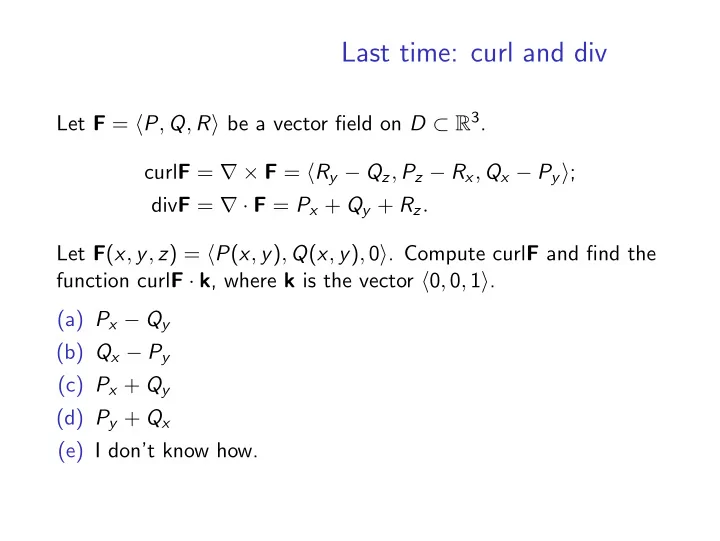

Last time: curl and div Let F = ⟨ P , Q , R ⟩ be a vector field on D ⊂ R 3 . curl F = ∇ × F = ⟨ R y − Q z , P z − R x , Q x − P y ⟩ ; div F = ∇ · F = P x + Q y + R z . Let F ( x , y , z ) = ⟨ P ( x , y ) , Q ( x , y ) , 0 ⟩ . Compute curl F and find the function curl F · k , where k is the vector ⟨ 0 , 0 , 1 ⟩ . (a) P x − Q y (b) Q x − P y (c) P x + Q y (d) P y + Q x (e) I don’t know how.
Solution Find curl ⟨ P ( x , y ) , Q ( x , y ) , 0 ⟩ · ⟨ 0 , 0 , 1 ⟩ . curl ⟨ P ( x , y ) , Q ( x , y ) , 0 ⟩ = ⟨ ∂ 0 ∂ z − ∂ 0 ∂ y − ∂ Q ∂ z , ∂ P ∂ x , ∂ Q ∂ x − ∂ P ∂ y ⟩ = ⟨ 0 , 0 , Q x − P y ⟩ . So curl ⟨ P ( x , y ) , Q ( x , y ) , 0 ⟩ · ⟨ 0 , 0 , 1 ⟩ = ⟨ 0 , 0 , Q x − P y ⟩ · ⟨ 0 , 0 , 1 ⟩ = 0 + 0 + Q x − P y = Q x − P y .
Physical interpretation of curl Let F be a vector field on D ⊂ R 3 , representing the velocity of a fluid flowing through the region D . For a point P ∈ D , we consider the vector curl( F )( P ). ∙ The line through P in the direction of curl( F )( P ) is the axis of rotation of a tiny ball at point P . ∙ The direction of curl( F )( P ) is related to the direction of rotation by the right-hand rule. ∙ The magnitude | curl( F )( P ) | is proportional to the speed of rotation. In particular, when curl( F ) = 0, the little ball doesn’t rotate at all; we say that F is irrotational at P . Note: the ball can still be moving! It’s floating along the current, it’s just not spinning as it moves past the point P .
Practice with curl Let F ( x , y , z ) = ⟨ y , 0 , 0 ⟩ . By imagining a tiny ball placed at different locations in the vector field, decide whether curl( F ) points up, points down, or is zero. (a) It always points up. (b) It always points down. (c) It’s always zero. (d) It depends what point we look at. (e) I don’t know. If you’re done, calculate curl( F ) from the definition and see if it matches your prediction. The correct answer is (b); you can check that curl( F ) = ⟨ 0 , 0 , − 1 ⟩ .
Physical interpretation of div ∙ If div F is positive, fluid flows out of B , a small ball around the point. ∙ If div F is negative, fluid flows in to B . ∙ If div F is zero, there is no net change: the volume of fluid coming in is equal to the volume of fluid going out. In that case, we say that F is incompressible .
Practice with div Let F ( x , y , z ) = ⟨ x , 0 , 0 ⟩ . Imagine a small region around a point. Is fluid leaving the region more quickly than it is entering it? Use your observation to decide whether div F is (a) always positive. (b) always negative. (c) always zero. (d) It depends on the point. (e) I don’t know. If you’re done, calculate div F from the definition, and see if your prediction is correct. The correct answer is (b): more fluid is leaving the small region; and you can check that div F = ⟨ 1 , 0 , 0 ⟩ .
Recommend
More recommend